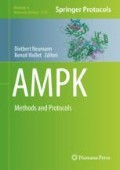Abstract
AMP-activated protein kinase (AMPK) is a critical energy sensor, regulating signaling networks involved in pathology including metabolic diseases and cancer. This increasingly recognized role of AMPK has prompted tremendous research efforts to develop new pharmacological AMPK activators. To precisely study the role of AMPK, and the specificity and activity of AMPK activators in cellular models, genetic AMPK inactivating tools are required. We report here methods for genetic inactivation of AMPK α1/α2 catalytic subunits in human cell lines by the CRISPR/Cas9 technology, a recent breakthrough technique for genome editing.
Access this chapter
Tax calculation will be finalised at checkout
Purchases are for personal use only
References
Zhang F, Wen Y, Guo X (2014) CRISPR/Cas9 for genome editing: progress, implications and challenges. Hum Mol Genet 23(R1):R40–R46
Ran FA, Hsu PD, Lin CY, Gootenberg JS, Konermann S, Trevino AE, Scott DA, Inoue A, Matoba S, Zhang Y, Zhang F (2013) Double nicking by RNA-guided CRISPR Cas9 for enhanced genome editing specificity. Cell 154(6):1380–1389
Ran FA, Hsu PD, Wright J, Agarwala V, Scott DA, Zhang F (2013) Genome engineering using the CRISPR-Cas9 system. Nat Protoc 8(11):2281–2308
Paquet D, Kwart D, Chen A, Sproul A, Jacob S, Teo S, Olsen KM, Gregg A, Noggle S, Tessier-Lavigne M (2016) Efficient introduction of specific homozygous and heterozygous mutations using CRISPR/Cas9. Nature 533(7601):125–129
Hardie DG (2013) The LKB1-AMPK pathway-friend or foe in cancer? Cancer Cell 23(2):131–132
Hardie DG, Ross FA, Hawley SA (2012) AMPK: a nutrient and energy sensor that maintains energy homeostasis. Nat Rev Mol Cell Biol 13(4):251–262
Chen L, Chen Q, Deng G, Kuang S, Lian J, Wang M, Zhu H (2016) AMPK activation by GSK621 inhibits human melanoma cells in vitro and in vivo. Biochem Biophys Res Commun 480(4):515–521
Jiang H, Liu W, Zhan SK, Pan YX, Bian LG, Sun B, Sun QF, Pan SJ (2016) GSK621 targets glioma cells via activating AMP-activated protein kinase signalings. PLoS One 11(8):e0161017
Wu YH, Li Q, Li P, Liu B (2016) GSK621 activates AMPK signaling to inhibit LPS-induced TNFalpha production. Biochem Biophys Res Commun 480(3):289–295
Sujobert P, Poulain L, Paubelle E, Zylbersztejn F, Grenier A, Lambert M, Townsend EC, Brusq JM, Nicodeme E, Decrooqc J, Nepstad I, Green AS, Mondesir J, Hospital MA, Jacque N, Christodoulou A, Desouza TA, Hermine O, Foretz M, Viollet B, Lacombe C, Mayeux P, Weinstock DM, Moura IC, Bouscary D, Tamburini J (2015) Co-activation of AMPK and mTORC1 induces cytotoxicity in acute myeloid leukemia. Cell Rep 11(9):1446–1457
Saito Y, Chapple RH, Lin A, Kitano A, Nakada D (2015) AMPK protects leukemia-initiating cells in myeloid leukemias from metabolic stress in the bone marrow. Cell Stem Cell 17(5):585–596
Gilbert LA, Horlbeck MA, Adamson B, Villalta JE, Chen Y, Whitehead EH, Guimaraes C, Panning B, Ploegh HL, Bassik MC, Qi LS, Kampmann M, Weissman JS (2014) Genome-scale CRISPR-mediated control of gene repression and activation. Cell 159(3):647–661
Sakuma T, Nishikawa A, Kume S, Chayama K, Yamamoto T (2014) Multiplex genome engineering in human cells using all-in-one CRISPR/Cas9 vector system. Sci Rep 4:5400
Tiscornia G. SOaVI (2007) Development of lentiviral vectors expressing siRNA. CSH protocols:23–34
Konermann S, Brigham MD, Trevino AE, Joung J, Abudayyeh OO, Barcena C, Hsu PD, Habib N, Gootenberg JS, Nishimasu H, Nureki O, Zhang F (2015) Genome-scale transcriptional activation by an engineered CRISPR-Cas9 complex. Nature 517(7536):583–588
Bell CC, Magor GW, Gillinder KR, Perkins AC (2014) A high-throughput screening strategy for detecting CRISPR-Cas9 induced mutations using next-generation sequencing. BMC Genomics 15:1002
Kornblau SM, Coombes KR (2011) Use of reverse phase protein microarrays to study protein expression in leukemia: technical and methodological lessons learned. Methods Mol Biol 785:141–155
Acknowledgments
Work from the authors was performed within the Département Hospitalo-Universitaire (DHU) AUToimmune and HORmonal diseaseS (AUTHORS) and was supported by grants from INSERM, CNRS, Université Paris Descartes, and Société Francophone du Diabète (SFD). J.M. was supported by a fellowship from AP-HP. A.G. holds a doctoral fellowship from CARPEM. S.O. received a doctoral fellowship from the Région Ile-de-France (CORDDIM).
Author information
Authors and Affiliations
Corresponding authors
Editor information
Editors and Affiliations
Rights and permissions
Copyright information
© 2018 Springer Science+Business Media, LLC
About this protocol
Cite this protocol
Grenier, A. et al. (2018). Knockdown of Human AMPK Using the CRISPR/Cas9 Genome-Editing System. In: Neumann, D., Viollet, B. (eds) AMPK. Methods in Molecular Biology, vol 1732. Humana Press, New York, NY. https://doi.org/10.1007/978-1-4939-7598-3_11
Download citation
DOI: https://doi.org/10.1007/978-1-4939-7598-3_11
Published:
Publisher Name: Humana Press, New York, NY
Print ISBN: 978-1-4939-7597-6
Online ISBN: 978-1-4939-7598-3
eBook Packages: Springer Protocols

